Bethlehem Lutheran Church: A Community Pillar in Round Top
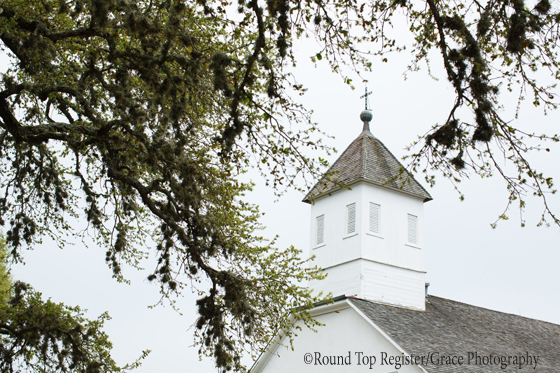
2025 Spring Antiques Show | March 20 – April 6
2025 Fall Antiques Show | October 4 – 18
For 150 years, Bethlehem Lutheran Church has been a community pillar in Round Top. The history of the church and the town are deeply intertwined.
“For where two or three gather in my name, there am I with them.”
Matthew 18:20
THE FAITHFUL MOVE FORWARD
by Lorie Woodward Cantu
The fifth Sunday in Lent spring began dominating winter. Bluebonnets and Indian paintbrushes embellished the graves of Bethlehem Lutheran Church’s founding members who repose under an emerald green carpet. Ancient live oaks stood sentinel. These would have been saplings when the pioneers broke ground for the church in 1866.
 Names such as Bauer, Rummel, Giese, Marburger, Zander and Erhlich are etched on the weathered tombstones, a tangible reminder that the congregation’s roots stretch across the Atlantic to Germany. The earliest birth date I spot is 1807. The hardships of constant war and the promise of opportunity inspired the settlers to leave the old country for a new land.
Names such as Bauer, Rummel, Giese, Marburger, Zander and Erhlich are etched on the weathered tombstones, a tangible reminder that the congregation’s roots stretch across the Atlantic to Germany. The earliest birth date I spot is 1807. The hardships of constant war and the promise of opportunity inspired the settlers to leave the old country for a new land.
The clear light of early morning streamed through the little church’s stained glass windows dappling the sanctuary with color. Clocks, at Congressional mandate, had sprung forward at midnight, but people still gathered early. Quiet greetings were delivered with handshakes, hugs and laughter.
As a stranger in their midst, I was struck by the warmth and the welcome. If you’ve ever visited churches, you know, unfortunately, that’s not always the case. I slipped into the pew behind Jeep and Ruth Menking who, at 93 and 91, have been members of the congregation for much of their lives. Mrs. Ruth earned her five-year Sunday school pin as a child, and they were married here on January 20, 1946. They continue to usher today.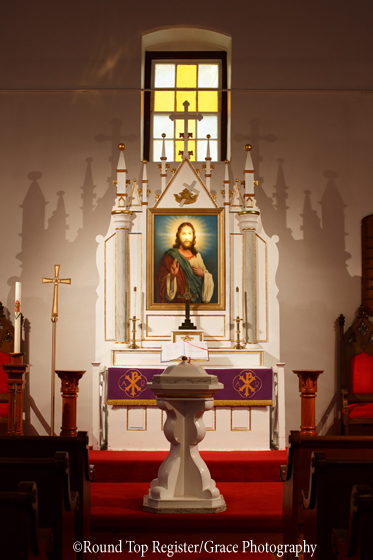
On this particular Sunday, there were about 45 at worship. While the congregation is small, it’s certainly not dying. Young families, empty nesters and nonagenarians were represented in equal number. According to Julie Wantland, a member who is active on the church’s sesquicentennial committee, the congregation is a blend of the ancestors of the founding families who have remained in the area throughout their lives, ancestors of the founding families who have returned to the area after careers took them away for a while, and those, like her, who have moved into the region.
When the prelude began, I was surprised to hear music wafting from the loft housing the Wandke Organ, one of Texas’ oldest. I assumed the congregation would save the historic organ for special occasions and rely on one of the two electric instruments in the chapel. Despite the difficulty of playing the 19th century instrument, which has pipes made from local cedar instead of the traditional metal, its music regularly enhances worship and serves as another reminder of the congregation’s ongoing history.
 Pastor John David Nedbalek, whose youthful face and enthusiasm belies his 15 years of pastoral experience, was teaching from the Gospel of John. It was the story of Mary, sister of Lazarus, who anointed Jesus’ feet with costly perfume and was chastised by one of the disciples for her extravagance. The pastor’s theme was “Extravagant Love.”
Pastor John David Nedbalek, whose youthful face and enthusiasm belies his 15 years of pastoral experience, was teaching from the Gospel of John. It was the story of Mary, sister of Lazarus, who anointed Jesus’ feet with costly perfume and was chastised by one of the disciples for her extravagance. The pastor’s theme was “Extravagant Love.”
During the Children’s Word, Pastor Nedbalek used the love of their parents to draw a parallel between the love of Jesus. After establishing that parents take care of us, Pastor Nedbalek asked the crowd of youngsters, “Who is always perfect for their parents?” Two hands, belonging to two blonde twin sisters, shot up. The congregation, including their parents, laughed appreciatively.
As is the tradition of the Evangelical Lutheran Church of America, of which Bethlehem Lutheran Church is a member through the Texas-Louisiana Gulf Coast Synod, the communion table is open. This means anyone professing belief in Jesus Christ is welcome to the Eucharist, which was served by intinction, dipping the unleavened wafer into the chalice of wine. Although the communion liturgy was sung not spoken, the liturgy was comfortably familiar to this Methodist.
At the service’s conclusion, the congregation immediately convened a meeting to discuss maintenance issues. The challenges and responsibilities of maintaining a historic structure are real. Not only did the congregation have to address “modern” issues such as replacing the sanctuary’s heating system, but long-term issues. When Carl Siegismund Bauer built the venerable church, he stacked native sandstone to build the walls and then covered them with plaster.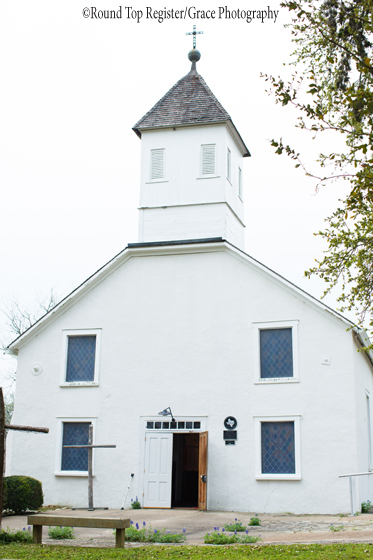
In Fayette County, rain and drought cause the land to expand and contract. The stacked stone shifts. Cracks in the plaster and seams around the wooden window frames allow water to seep inside the walls hastening the deterioration of the soft sandstone. Stabilizing the structure requires engineering solutions that change over time as new issues arise.
Lively discussions of emerging needs, alternative solutions and the ever present concern of finances resulted. After thoughtful consideration, the congregation, following in the faithful footsteps of previous generations, voted to tackle the challenges and march on side by side.
“Therefore everyone who hears these words of mine and puts them into practice is like a wise man who built his house on the rock. The rain came down, the streams rose, and the winds blew and beat against that house; yet it did not fall, because it had its foundation on the rock.” Matthew 7:24-27
Carl Siegismund Bauer, an only child, was born September 14, 1792 in Wiesa in the Kingdom of Saxony. Early on Bauer demonstrated a knack for engineering by constructing a system of lifts and locks to provide irrigation from the Elbe River to his family’s hay meadows.
When Bauer was 19, the French commandeered his family’s horses and wagon on their flight from Russia. To protect the family’s possessions, he accompanied the French eventually returning home safely with the valuable property.
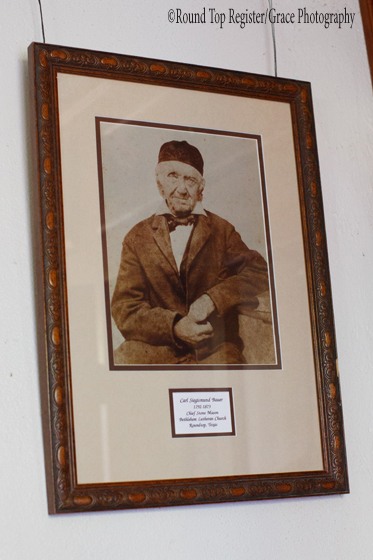 He was approaching age 21 and was unmarried, meaning he would soon be forced to serve in the military. Marriage would exempt him, but Bauer had shown no interest in the local maidens.
He was approaching age 21 and was unmarried, meaning he would soon be forced to serve in the military. Marriage would exempt him, but Bauer had shown no interest in the local maidens.
His anxious mother took matters into her own hands. First, she asked Christina Malzer, a young woman she was fond of, whether she’d be willing to marry Carl if he asked. Christina agreed. Mrs. Bauer cooked a fine meal and invited Christina over for Saturday dinner. Mrs. Bauer intercepted Carl on the way home from the fields and begged him to marry Christina to avoid the draft.
Being a dutiful son, who was caught completely off guard, he agreed.
With Bauer’s birthday fast approaching, the plan took on a sense of urgency. Local custom required marriage banns to be read in church for three consecutive weeks prior to the marriage, so after dinner the trio walked to the local Lutheran parsonage. It was late. They roused the pastor from his sleep and convinced him to make the necessary announcements beginning the next morning.
Walking home the trio planned the young couple’s future. Bauer would inherit the family’s two story stone house with a fine garden and orchard.
Thirty years later, in 1847, with the German Revolution in full swing, August, Bauer’s third child of nine, and his wife Emilie boarded the ship Franziska in Bremen and headed for America. August and Emilie settled in Spring Branch with other Lutheran families and sent glowing descriptions of life in America, which included a plentiful supply of meat, a rare luxury in war-torn Germany.
By 1848 Saxony was under Russian rule. Now in their late 50s, Carl and Christina, along with four of their children and one son-in-law (Wilhelmine 23, Carl Ehrgott 20, Carl Traugott 18, and Caroline 32 and husband Carl William Rummel 36) boarded the ship Neptune bound for America.
The unseaworthy Neptune finally delivered the family to Galveston on December 15, 1848.
After the long voyage, they embarked on a nine-mile journey to join August and Emilie in Spring Branch. They walked through the marsh alongside an oxcart. Arriving tired and cold, they discovered the only available house was an old weather-beaten shack that was too small for so many people.
The year 1849 was wet, which brought mosquitoes by the droves. Yellow fever and malaria killed many including Carl’s wife Christina only 10 months after their arrival.
By 1851, three of Carl Sr.’s children had moved to Round Top. Carl Ehrgott, a son, and son-in-law Conrad Schueddemagen were the first Germans to buy lots in Round Top. Carl Sr. left his Spring Branch property under the care of his son August and moved to Round Top.
In 1852, Carl Sr. oversaw the construction of the Schueddmagen House, a home for his daughter Wilhelmine and son-in-law Conrad, basing its design on the Bauer’s ancestral home in Germany.

Using local materials, Carl Sr. built the walls from stacked sandstone sealed with plaster. It’s the construction method he would use when he led his sons and son-in-law to build Bethlehem Lutheran Church. He was in his seventies when the project began. The church was dedicated on October 23, 1866.
“Even youths grow tired and weary, and young men stumble and fall; but those who hope in the Lord will renew their strength. They will soar on wings like eagles; they will run and not grow weary, they will walk and not be faint.” Isaiah 40:30-31
Round Top, originally called Townsend, was established before the Texas Revolution and was home to many who fought with General Sam Houston. Beginning in 1850, German settlers began buying town lots and gradually bought out the Americans making it a distinctly German settlement. The population was 150. The community had two stores, two blacksmith shops, two taverns, a post office and a line of tri-weekly stages.

As noted by various pastors on their travels through the area, Lutheranism arrived in Fayette County in 1853. On May 22, 1856 the First Evangelical Lutheran Synod of Texas recorded a congregation in Round Top. A small church was erected about two miles from Round Top in 1859.
The U.S. Census of 1860 shows that German settlers owned 129 farms in the Round Top area, and the 1860 Lutheran convention records note the Round Top church had 47 families as members.
In late 1860, Pastor Adam Neuthard landed at Galveston and was installed at Bethlehem Lutheran. Just a few months into Pastor Neuthard’s tenure, the Civil War began. The last thing Germans settlers wanted was another war reminiscent of those they had fled. Although the settlers opposed slavery and secession, they and their sons were marched off to war.
The Civil War ended on May 9, 1865, and on September 29, 1865 Pastor Neuthard purchased block 27 in Round Top.
These were hard times. Yellow fever, malaria, cholera, influenza and pneumonia filled the cemeteries. Families grieved for husbands and sons lost to the war. Food and other necessities were scarce.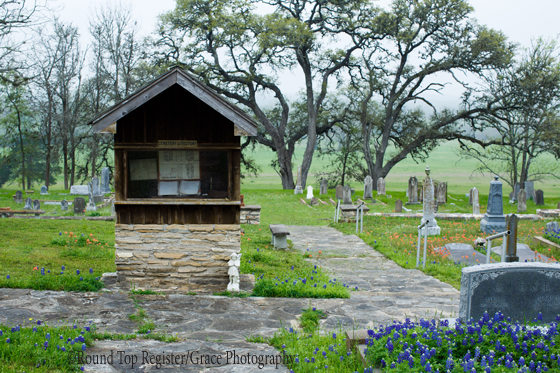
And yet, by 1866, these hardy souls, under the most challenging circumstances, had erected the building in which the congregation worships today.
“Our ancestors were strong in body and faith—and they needed to be to survive all the challenges placed in their paths on a way to a new life in Round Top. Hold onto that precious family story, photo or church document you might have from one of your forbears. With so many obstacles to overcome, it must have been vitally important to them to put these things away in the hope these memories would someday be in the hands of future generations.” Gesine Koether
“Praise the LORD! Praise God in His sanctuary… . Praise Him according to His excellent greatness. Praise Him with trumpet sound; Praise Him with harp and lyre. Praise Him with timbrel and dancing; Praise Him with stringed instruments and pipe… . Praise Him with resounding cymbals. Let everything that has breath praise the LORD.” Psalm 150: 1-6
Editor’s Note: The University of Houston’s College of Engineering presents a series, Engines of Ingenuity, about the machines that make our civilization run and the people whose ingenuity created them. The following was Number 530, and we were graciously allowed to reprint the transcript. You may listen to the original broadcast of this episode at www.uh.edu/engines/epi530.htm.
Traugott Wandke (or Wantke, depending on the source) got off the sailing ship Weser in Galveston. It was May 4, 1855. Wandke was 47 years old. He’d spent two months crossing from Bremen, Germany. Now he was tired, seasick and ready to head inland to begin a new life. He would eventually settle in Round Top.
He brought considerable mechanical skill to this primitive land. Wandke went to work making church furniture and repairing watches. He did carpentry, tinsmithing and locksmithing.
 Wandke also had some modest ability as a musician. He brought with him an obscure book of German chorales. He could play most of them but not much else. He sang in his church choir. Old-timers from Round Top said he would walk through town singing a single sustained high note. They said it was a high G. Then, in his mid-50s, Wandke began work on an organ for the Bethlehem Lutheran Church. There’s no hard evidence that he’d ever built an organ before. He might have, but it was common for the people who shaped life in our wilderness to do it without the expertise one would expect. And, in 1865, Round Top lay on the very edge of the American frontier.
Wandke also had some modest ability as a musician. He brought with him an obscure book of German chorales. He could play most of them but not much else. He sang in his church choir. Old-timers from Round Top said he would walk through town singing a single sustained high note. They said it was a high G. Then, in his mid-50s, Wandke began work on an organ for the Bethlehem Lutheran Church. There’s no hard evidence that he’d ever built an organ before. He might have, but it was common for the people who shaped life in our wilderness to do it without the expertise one would expect. And, in 1865, Round Top lay on the very edge of the American frontier.
Before his death in 1870, Wandke built seven pipe organs from scratch. It’s amazing how well he did at it. Three still exist including the Bethlehem Church organ which is still in use. Let’s look at these old engines of Wandke’s ingenuity.
The organs were beautifully made. They’re self-contained units in fine wood cabinets. Wandke put them together with hand-turned wooden screws. He made the pipes from hand-planed wood. His organs are typically about ten feet high and six feet wide. Most of the wood in them is local cedar. They still perfume rooms with a delicate smell.

The level of craftsmanship is remarkable. These are no historical curiosities. They’re nice, playable instruments. They have a gentle, mellow sound. The voicing is uniform and musical. The action is good.
Yet, they’re idiosyncratic. They’re the work of a man separated from the organ-building practice of his day. One modern builder points out that the design and the list of organ stops were 50 years out of date, even in 1865.
That’s how the first organs were built in Texas. This was a hard and barren land. The first order of business was to bring some beauty into it to make it bearable. That’s what Wandke did. That’s what fired his technological genius. Beauty has always been the first business of any technology in any age.
“Then I will give you shepherds after my own heart, who will lead you with knowledge and understanding.” Jeremiah 3:15
Pastor John David Nedbalek, a former farmer, wears boots and blue jeans under his ministerial robe.
“I came to the ministry after God blessed me with two consecutive crop failures,” Nedbalek, who was reared on a cotton and grain sorghum farm near Sinton, said laughing. “As one of my neighbors once told me, ‘Farming is a damn fine life, but a damn poor way to make a living.’”

The Aggie also worked as a civil engineering consultant and substitute teacher before answering the call to go to seminary.
“On my first day, a member of the congregation noticed my boots and blue jeans and said, ‘Pastor, I think you’re going to be here a long time,’” Nedbalek said. “I miss farming, but coming to Round Top was like coming home. This congregation is full of good rural people. I understand their values, and they understand mine.”
He and his wife, Melissa, came to Bethlehem Lutheran Church 15 years ago. It was their first pastorate. Unlike many young ministerial couples who view each church as a stepping stone to a larger congregation, the Nedbaleks were looking to put down roots. In fact, they were the first ministerial couple in recent history to have their children born into the congregation. Abbey is 13 and Austin is 11.
“When we go to visit our families in Sinton and Fredericksburg, our kids will ask when are we going home to Round Top?” Nedbalek said. “This tells me that we’re building something here.”
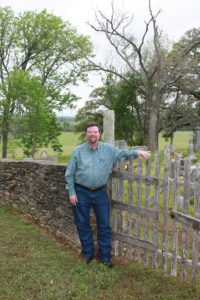
Early on, the young family struggled with the distance between them and their extended families. They turned to a mentor who suggested they look at the elders in the congregation as a pool of grandparents for their youngsters, cultivate those relationships and draw on their collective wisdom.
“That discussion changed our perspective and opened up so many beautiful possibilities,” he said.
As one example, he shared the story of Clarence and Shirley Wagner, who his children knew as Uncle Clarence and Aunt Shirley although they were not relatives. The Wagners were part of the Nedbalek children’s lives celebrating birthdays, attending school events and opening their home for meals and sleepovers. Last April, Clarence, who had once played minor league baseball and maintained a lifelong passion for the game, died. Austin, also an avid baseball player, was in the middle of a game when Nedbaleck got the sad news. Nedbalek decided to wait until the game’s conclusion to tell his then 10-year-old son.
Upon hearing that Uncle Clarence had died, Austin dropped his post-game drink and began to cry. He asked, “Why didn’t you tell me sooner, Dad?”
Nedbalek replied, “I didn’t want you to be upset during the game.”
Austin replied, “I wish you would’ve told me Dad. I would’ve hit one over the fence for Uncle Clarence.”
Losing the people who have been pillars in the congregation for 80 or 90 years is a challenge because they represent institutional knowledge, wisdom and friendship.
“The funerals just get harder,” Nedbalek said. “But then I get to perform baptisms and confirmations for the 35 young people we have in our midst. I’m part of the circle of life in this congregation and this community, but I never forget that I’m just a shepherd.”
Whether in a pasture or a pastorate, good shepherds guide their flocks but don’t dominate.
“The way that I look at it is that this church was God’s before I got here, and it will be God’s when I leave,” Nedbalek said. “I’m humbled by the opportunity to serve in this historic setting, but my responsibility is to empower the people to take charge of this congregation and run with it.
“Obviously, I’m here to help, but if I take sole responsibility for shaping it, then it becomes what I want, but if the congregation shapes it, it is theirs. I came in as an outsider; I’m ministering as an outsider, and someday I will leave as an outsider, but the people will remain to continue their proud tradition into the future.”
The congregation at Bethlehem Lutheran Church has celebrated 150 years of faith and fellowship by hosting special anniversary services throughout the year. Services are held each Sunday at 9:30 a.m. and are open to anyone who would like to attend.
“The special services are a wonderful way for members of our community to join us and celebrate the shared history of our church that has long been a central part of life in Round Top,” Wantland said.
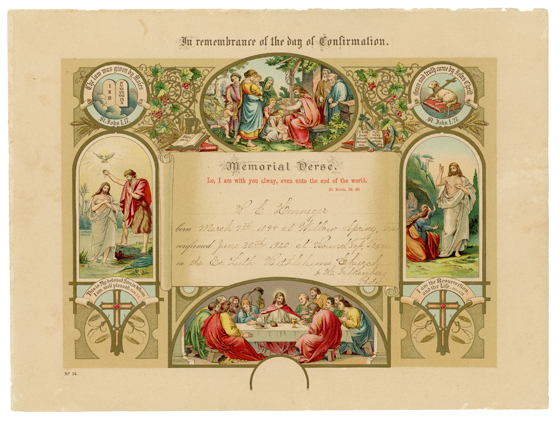
The remaining special services are scheduled for:
June 19
Anniversary Service
July 17
Pipe Organ Service
August 21
Anniversary Service
September 18
Country Western Service
October 23
Grand Anniversary Service
Officiated by Bishop Michael Rinehart
Community meal at Round Top Rifle Hall
November 20
Anniversary Service
For more information about these services, the Bethlehem Lutheran Church office can be reached at 979-249-3686 or [email protected].
2025 Spring Antiques Show | March 20 – April 6
2025 Fall Antiques Show | October 4 – 18